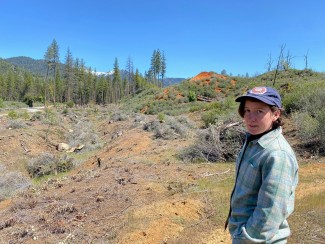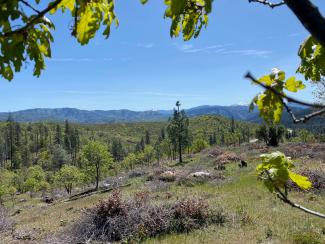Shasta-Trinity National Forest and Trinity County RCD partner to create a Healthier Forest
by Robert Doucette, Shasta-Trinity National Forest, Public Affairs Office
WEAVERVILLE, Calif. – When Bethany Llewellyn heads out for a run on her local trails, she can see evidence of the lasting effects of wildfire.

Bethany Llewellyn, forest health program manager at the Trinity County Resource Conservation District, shows where forest health work is being accomplished in the Weaverville Community Forest.
Photo Credit: Robert DoucetteBut there’s something else here, too.
Instead of dense forest choked with underbrush, she sees a mix of mature broadleaf and conifer trees, spaced far enough apart to allow grasses and younger trees to take root. This part of the forest is healthy. And a healthy forest is less likely to succumb to catastrophic wildfire.
This is what Trinity County forests can look like with the right kind of forest management practices.
But given the vast spread of woodlands in Trinity County, transforming a vulnerable landscape into something less prone to disaster is a job too big for any single agency or organization to take on alone. Instead, it takes a team.
Llewellyn, Forest Health Program manager at the Trinity County Resource Conservation District (TCRCD), represents a local agency partnering with the Shasta-Trinity National Forest to tackle one of the most urgent projects in America’s western woodlands: restoring the forest around her hometown into something more sustainable for the landscape and safer for the people who live there.
“I think there’s an energy for that kind of forest management,” Llewellyn said.

Slopes near Oregon Mountain, just outside of Weaverville, California, show where forest health work is being accomplished.
Photo Credit: Robert DoucetteTCRCD is one of many partner agencies and organizations working with the Shasta-Trinity National Forest in implementing its Wildfire Crisis Strategy. Local, state and federal agencies, Tribes, nonprofit agencies and local businesses are combining their efforts to mitigate wildfire risk in 21 landscapes across the American west. These landscapes were chosen based on their vulnerability to wildfire and are in a drier, warmer environment – an environment in which many U.S. forests exist.
Catastrophic wildfire not only threatens long-term damage to forests, but also poses a major risk to water quality, wildlife habitat, property and human life.
“It’s an area of concern for us because it’s right in our backyard,” Llewellyn said, noting that there are forest stands that are too dense and at times afflicted with trees that are dying or dead because of climate-change stressors, insect infestation and disease.
“It causes intense, fast-burning canopy fires,” she said.
To combat this, forest managers have several tools at their disposal. Building fuel breaks – areas where vegetation is largely cleared to form defensible positions – is one method. Others include thinning forest stands so they aren’t as dense. Underbrush can be removed and later burned. And finally, prescribed burns – where small fires are intentionally set and controlled – can be used to clear flammable vegetation on the forest floor in a way that mimics natural, healthy fire.
You can see what these projects look like in various places within the nearly 15,000-acre Weaverville Community Forest, where about 80% lies within U.S. National Forest Service boundaries.
North of town, a recently treated area has seen underbrush cut, cleared and organized into piles that will be burned once cooler fall temperatures arrive. To the casual observer, it can look stark at first. But further up the road, you can see where previous treatments have led to a healthier forest landscape.
In these places, small oak trees are taking root. Spacing between trees has allowed grasses and seedling trees room to grow without being suffocated by dense forest canopy. A healthier balance between evergreens and deciduous trees is starting to form.
Back on the trail system in town, a different picture appears. Amid the burn area of the Oregon Fire (2008), healthy oaks populate the hillsides alongside a scattering of mature ponderosa pines. Patches of meadow break up the landscape, allowing grasses to flourish.

Bethany Llewellyn, Forest Health Program manager at the Trinity County Resource Conservation District (TCRCD), looks out toward a healthier part of the Weaverville Community Forest.
Photo Credit: Robert DoucetteIt’s a different looking forest than what was here 10 years ago, and certainly different from the at-risk forests nearby. More importantly, this part of the forest is far more likely to survive the next fire, as the potential for crown fire – when wildfire gets into the canopy of a forest and spreads quickly from tree to tree – is significantly reduced.
When the rest of the forest around Weaverville resembles this part of the landscape, the town will be at a reduced risk for a potential disaster similar to those that have haunted other mountain towns in California and throughout the West. In the long term, a healthier ecosystem and watershed will be the result.
This work is made possible because so many partners have joined forces to tackle the challenge of preventing catastrophic wildfire.
The Watershed Research & Training Center and the U.S. Bureau of Land Management are among those working with the Forest Service and TCRCD on the Weaverville Community Forest. The Weaverville Community Forest Steering Committee, made up of community volunteers, works with land managers to ensure management aligns with the needs of the community.
Local businesses are also taking part. Sierra Pacific Industries and Trinity River Lumber/Corral Creek Timber have had a role in work being done at the Weaverville Community Forest.
“That’s part of the vision,” Llewellyn said. “Industry is a part of successful forest management.”
A team like this is what it will take to make the Wildfire Crisis Strategy succeed in reducing risk to communities and the forests that surround them.
“The dedication and effort of the TCRCD has led to invaluable contributions to help aid the Forest Service’s Wildfire Crisis Strategy,” said Marcus Nova, who is helping to lead the Forest Service’s Wildfire Crisis Strategy efforts. “We appreciate the TCRCD’s willingness to apply and implement this project to make great strides in forest health on both public and private lands.”


